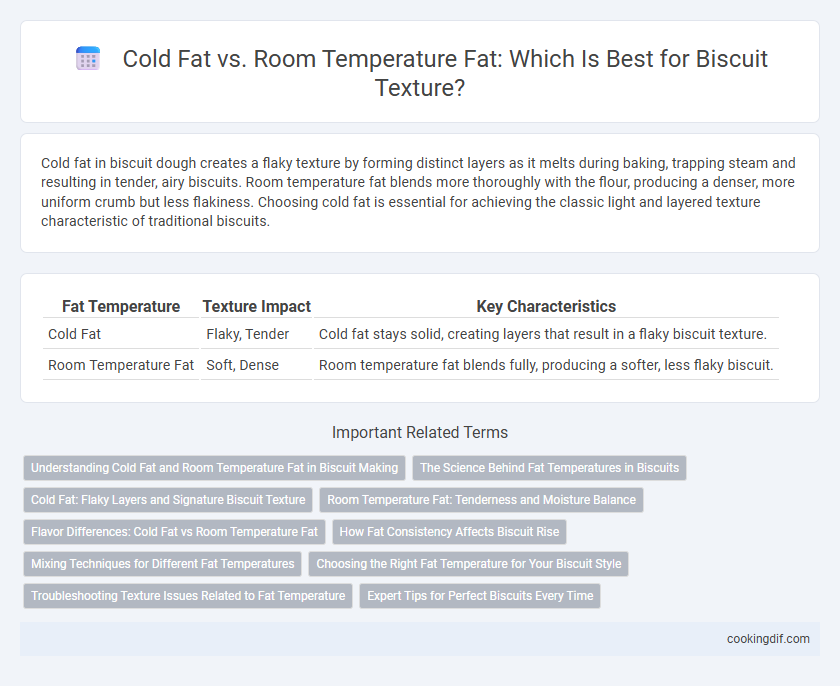Cold fat in biscuit dough creates a flaky texture by forming distinct layers as it melts during baking, trapping steam and resulting in tender, airy biscuits. Room temperature fat blends more thoroughly with the flour, producing a denser, more uniform crumb but less flakiness. Choosing cold fat is essential for achieving the classic light and layered texture characteristic of traditional biscuits.
Table of Comparison
| Fat Temperature | Texture Impact | Key Characteristics |
|---|---|---|
| Cold Fat | Flaky, Tender | Cold fat stays solid, creating layers that result in a flaky biscuit texture. |
| Room Temperature Fat | Soft, Dense | Room temperature fat blends fully, producing a softer, less flaky biscuit. |
Understanding Cold Fat and Room Temperature Fat in Biscuit Making
Cold fat creates flaky layers in biscuits as it melts during baking, producing pockets of steam that lift the dough. Room temperature fat blends more thoroughly with flour, resulting in a tender, cake-like texture. Mastering the temperature of fat is essential for achieving the desired biscuit crumb and flakiness.
The Science Behind Fat Temperatures in Biscuits
Cold fat creates steam pockets in biscuit dough, resulting in a flakier and lighter texture due to the fat melting slowly during baking. Room temperature fat blends more thoroughly with flour, leading to a denser, softer biscuit with less distinct layers. The temperature of fat fundamentally influences gluten development and the distribution of fat particles, which determines the final crumb structure and mouthfeel.
Cold Fat: Flaky Layers and Signature Biscuit Texture
Cold fat is essential for creating flaky layers and the signature texture of biscuits by remaining solid during mixing, which prevents it from fully blending into the flour. As the dough bakes, the cold fat melts and releases steam, causing pockets that contribute to a tender, airy crumb. Using cold fat like butter or shortening results in a biscuit with distinct, delicate layers and a desirable crumb structure.
Room Temperature Fat: Tenderness and Moisture Balance
Room temperature fat in biscuit dough creates a tender texture by blending evenly with flour, allowing for balanced moisture distribution that enhances softness. Unlike cold fat, which creates distinct flakiness by melting during baking, room temperature fat integrates fully to maintain consistent crumb structure and delicate mouthfeel. This method promotes optimal tenderness and moisture retention, resulting in biscuits that are both moist and tender without being greasy or crumbly.
Flavor Differences: Cold Fat vs Room Temperature Fat
Cold fat in biscuits creates a flaky texture by forming distinct layers as the fat melts during baking, preserving buttery pockets that enhance flavor richness. Room temperature fat blends more thoroughly into the dough, producing a tender, cakier biscuit with a milder, more uniform taste. The choice between cold and room temperature fat directly influences both the biscuit's mouthfeel and the intensity of its buttery flavor.
How Fat Consistency Affects Biscuit Rise
Cold fat creates small pockets of solid fat that melt slowly during baking, resulting in flaky, tender layers and a higher biscuit rise. Room temperature fat blends more thoroughly with flour, producing a denser texture and less pronounced layering. The temperature and consistency of fat significantly influence the biscuit's crumb structure and overall fluffiness.
Mixing Techniques for Different Fat Temperatures
Cold fat creates flaky biscuit layers by remaining solid during mixing, forming distinct pockets of fat within the dough. Room temperature fat blends more uniformly, resulting in a softer, tender biscuit crumb with less pronounced layering. Adjust mixing techniques by using quick, light cutting motions for cold fat to retain flakes, while cream room temperature fat thoroughly to incorporate air and achieve a delicate texture.
Choosing the Right Fat Temperature for Your Biscuit Style
Cold fat creates flaky, layered biscuits by releasing steam during baking, which forms distinct pockets in the dough, while room temperature fat produces a tender, cake-like crumb by blending more thoroughly. For traditional flaky biscuits, use cold butter or shortening, cutting it into the flour to maintain solid fat pieces. If you prefer soft and tender biscuits, cream room temperature fat into the dough to incorporate air and achieve a finer texture.
Troubleshooting Texture Issues Related to Fat Temperature
Cold fat in biscuit dough creates flaky layers by forming steam pockets during baking, while room temperature fat blends more thoroughly, resulting in a tender, crumbly texture. Troubleshooting texture issues involves ensuring cold fat remains in small, solid pieces to avoid greasy, dense biscuits, whereas overly soft fat can cause spreading and loss of structure. Proper fat temperature directly influences gluten development and moisture retention, key factors in achieving the desired biscuit texture.
Expert Tips for Perfect Biscuits Every Time
Cold fat in biscuit dough creates flakier layers by melting during baking and releasing steam, which forms pockets of air. Room temperature fat blends more thoroughly, resulting in a softer, more tender texture but less rise. Expert tips recommend using cold butter or shortening for traditional flaky biscuits and incorporating small, evenly sized fat pieces to maximize lightness and flakiness.
Cold fat vs Room temperature fat for texture Infographic

 cookingdif.com
cookingdif.com